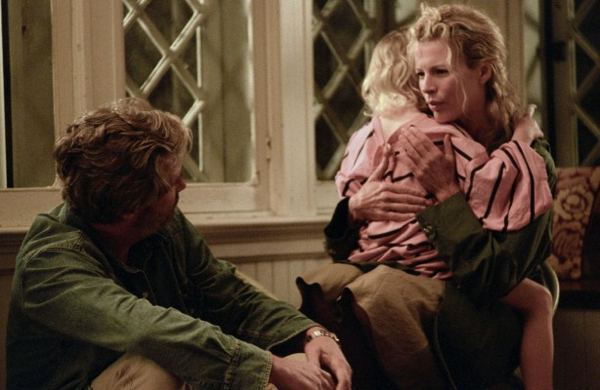Movie review by Greg Carlson
Truncating the John Irving novel upon which his movie is based, and changing the title from “A Widow for One Year” to “The Door in the Floor,” director Tod Williams manages an impressive feat of good moviemaking. Irving rarely makes it to the screen without an abundance of the florid sentimentalism that somehow works better on the page (think “The Cider House Rules” and “Simon Birch”), and for the most part, Williams steers clear of the obvious traps provided by a story that could so easily wallow in the loss of innocence, the loss of children, and the loss of a marriage. “The Door in the Floor” is by no means perfect, but it is entertaining, and features at least one performance that should not be missed.
Veteran actor Jeff Bridges plays children’s book author Ted Cole, an alcoholic and part-time nudist whose marriage has collapsed in the years following a freak accident that claimed the lives of his teenage sons. Ted’s separation from wife Marion (Kim Basinger) corresponds with the hiring of aspiring writer Eddie O’Hare (Jon Foster), an Exeter student who has arranged a summer internship with Ted. It doesn’t take Eddie long to discover that Ted only needs him as a driver, but Eddie is a polite kid, and he is also more than a little attracted to the practically catatonic Marion.
Before you can say Oedipus, Marion is instructing Eddie in the finer points of lovemaking, but the movie is resolute that sex is only one thing worth considering in this fascinating tableau. The principal trio deceive themselves as much as they deceive one another, but Williams (like Irving) is not terribly interested in generating any suspense related to dangerous liaisons. Instead, the filmmaker takes the time to explore the process of mourning, the discovery that one’s hero can be less than heroic, and the reality that grief is dealt with in unique ways by different people.
“The Door in the Floor” only falters toward the end, when a strange shift in tone makes room for a goofy slapstick sequence that would have worked better if more humor had been allowed in the first sections of the movie. Nearly all of the other details in the film are expertly observed, however, and Williams capitalizes on several visual motifs, including the quiet clicking of a turn signal, the fetishizing of undergarments, and the hallway shrine of photographs that makes the house feel like a mausoleum. Additionally, the misty environs surrounding Ted’s rambling Hamptons estate are beautifully photographed by Terry Stacey.
Even though plenty of plotting surrounds Eddie’s relationship with Marion, Williams ultimately settles on Ted as the central figure of the film (the final shot alone, a wordless summary of all that has come before, is thoughtfully linked to the new title). Bridges, who is surely one of the finest, most underrated actors of this or any other generation, provides Ted with unforgettable personality traits. Ted is larger than life, but somehow familiar: he is unfaithful to his wife, but is a good father to his daughter. He can be generous one second and completely vain and self-involved the next. It is only when you realize that Ted’s narcissism operates (like Marion’s silence) as a defense mechanism shielding him from his pain that the story comes into sharp focus. Many actors would embarrass themselves trying to deliver Ted’s rambling monologue that recounts the deaths of his sons. Bridges makes it look easy.
